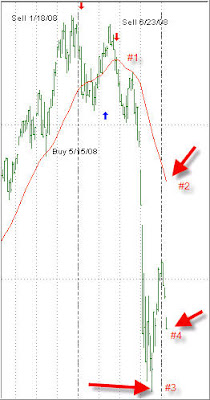 During the market meltdown of 2008, many stories surfaced of publicly traded companies complaining about short sellers contributing to the sharp decline of their stock price.
During the market meltdown of 2008, many stories surfaced of publicly traded companies complaining about short sellers contributing to the sharp decline of their stock price.
For the most part this was pure nonsense, but made for a nice excuse, as the fault of a sliding stock price was caused by poor management decisions or simply a failed business model.
Reader Paul submitted the following story about Porsche’s short-squeeze play, which caused sophisticated investors and hedge funds not only headaches but a lot of losses. “How Porsche hacked the financial system and made a fortune” is an interesting tale of how one company survived take-over attempts and shafted the big boys in the process:
In 1931, Austro-Hungarian engineer Ferdinand Porsche started a German company in his own name. It offered car design consulting services, and was not a car manufacturer itself until it produced the Type 64 in 1939. But things got interesting for Porsche long before then.
In 1933, he was approached by none other than Adolf Hitler, who commissioned a car designed for the German masses. Porsche accepted, and the result was the iconic Beetle, manufactured under the Volkswagen (lit. “people’s car”) brand. Today, Porsche’s company is one of the world’s premier luxury car brands, while Volkswagen (VW) is itself the world’s third-largest auto maker after General Motors and Toyota.
Three years ago, Volkswagen found itself fearing a foreign takeover. Porsche, the company, decided to step in and start buying VW stock ostensibly to protect the landmark brand, widely fueling market expectations that it would eventually buy Volkswagen outright. Of course, this isn’t quite what came to pass.
For three years, Porsche kept accumulating VW stock without telling anyone how much it owned. Every time it purchased more, the amount of free-floating VW stock would decrease, driving the stock price up slightly; your basic supply and demand at work. Eventually the share price became high enough that, to outside observers, it wouldn’t have made any sense for Porsche to buy Volkswagen. It would simply have cost too much.
To explain what happened next, I’m going to first tell you about a financial maneuver called shorting.
At any given point, only a certain amount of a publicly traded company’s stock is floating freely in the market. The rest is held in various portfolios, funds, and investment vehicles. Now, everyone’s familiar with the basic idea behind the stock market: you buy stock when it costs little, and you sell it when it costs a lot, profiting on the difference.
But that assumes a company’s value is going to increase. What if, instead of betting a company will go up, you want to make money betting the company will go down? You can — by selling stock you don’t own.
Say you borrow a certain amount of stock from someone who already owns it. You pay a fixed fee for borrowing the stock, and you sign a contract saying you will return exactly the same amount of stock you took after some amount of time. So, you might borrow a thousand shares of Apple stock from me (I don’t actually own any, but play along), pay me $100 for the privilege, and sign an obligation to return my stock in 3 months. At the time, Apple stock is worth $10 per share.
After you borrow the stock, you immediately sell it. At $10 a share, you get $10,000. Two and a half months later, another rumor about Steve Jobs’ health sends AAPL crashing to only $6 per share for a few hours, so you buy a thousand shares, costing you $6,000. You give me back those shares. Because you successfully bet the company would go down in value, you earned $4,000 minus the borrowing fee. This is called short-selling or shorting the stock, and the downside is obvious: if your bet was wrong, you would have lost money buying back the shares that you have to return to your lender.
Now things get kinky.
When Volkswagen’s share price exceeded the point where it made sense for Porsche to buy the company, a number of hedge funds realized that Volkswagen shares have nowhere to go but down. With Porsche out of the picture, there was simply no reason for VW to keep going up, and the funds were willing to bet on it. So they shorted huge amounts of VW stock, borrowing it from existing owners and selling it into circulation, waiting for the price drop they considered inevitable.
Porsche anticipated exactly this situation and promptly bought up much of these borrowed VW shares that the funds were selling. Do you see where this is going? Analysts did. According to The Economist, Adam Jonas from Morgan Stanley warned clients not to play “billionaire’s poker” against Porsche. Porsche denied any foul play, saying it wasn’t doing anything unusual.
But then, last October 26th, they stepped forward and bared their portfolio: through a combination of stock and options, they owned 75% of Volkswagen, which is almost all the company’s circulating stock. (The remainder is tied up in funds that cannot easily release it.)
To put it mildly, the numbers scared the living hell out of the hedge funds: if they didn’t immediately buy back the Volkswagen stock they were shorting, there might not be any left to buy later, and it isn’t their stock — they have to return it to someone. If their only option is thus to buy the VW stock from Porsche, then the miracle of supply and demand will hit again, and Porsche can ask for whatever price it wants per VW share — twenty times their value, a hundred times their value — because there’s no other place to buy. They’re the only game in town.
And that, my friends, is called a short squeeze.
Porsche’s ownership disclosure sent the hedge funds on such a flurry of purchases for any Volkswagen stock still in circulation that the VW share price jumped from below €200 to over €1000 at one point on October 28th, making Volkswagen for a brief time the world’s most valuable company by market cap.
On paper, Porsche made between €30-40 billion in the affair. Once all is said and done, the actual profit is closer to some €6-12 billion. To put those numbers in perspective, Porsche’s revenue for the whole year of 2006 was a bit over €7 billion.
Porsche’s move took three years of careful maneuvering. It was darkly brilliant, a wealth transfer ingeniously conceived like few we’ve ever seen. Betting the right way, Porsche roiled the financial markets and took the hedge funds for a fortune.





